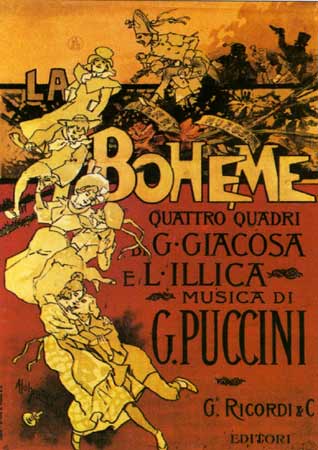 Why do I recommend La Bohème as a first opera? Well, for starters, it’s not long. (That matters, especially for kids.) It runs about two hours, with four short acts between that last about 30 minutes each. It boasts several “hit tunes” that are likely to be familiar (Musette’s waltz: Quando me’n vo’; Mimi’s plaintive aria Sì, mi chiamano Mimì).
Why do I recommend La Bohème as a first opera? Well, for starters, it’s not long. (That matters, especially for kids.) It runs about two hours, with four short acts between that last about 30 minutes each. It boasts several “hit tunes” that are likely to be familiar (Musette’s waltz: Quando me’n vo’; Mimi’s plaintive aria Sì, mi chiamano Mimì).
The main characters, the poor seamstress Mimi, the exuberant, impoverished poet Rudolfo, Rudolfo’s cheerful friend, the painter Marcello and his girlfriend, the vivacious singer Musette, have long ago entered the pantheon of classic dramatic figures.
La Bohème also offers one of the greatest crowd scenes ever written: the second-act Christmas Eve party on in the wintry streets of Paris’s Latin Quarter. Particularly in Zeffirelli’s production this scene is a masterpiece of micro-dramas woven into a tapestry of action.
The work intensifies towards the end when the focus becomes the demise of Mimi who fades away with the most beautiful lyricism you can imagine. Those tender melodies are set against Rudolfo’s passionate effort to keep her alive and, let’s face it, you never forget such scenes.
Traditionally, there were two ways to experience opera: first, fostering a familiarity with the ear-catching songs (arias), choruses, and instrumental numbers that abound in operas of virtually every period. That familiarity was accomplished most often, historically, by someone playing the music, perhaps in solo arrangements for piano or guitar, or in a duet form with two players at a piano. Or perhaps someone would actually sing through the most popular tunes of a given opera, accompanied by a family member or friend.
We have a hard time imagining regular folks spending their evenings singing through opera scores as the evening entertainment. But throughout a good deal of history, that would have been a popular social activity. And it worked. Nothing puts music into one’s head as quickly as playing or hearing it in an intimate setting.
The second way, of course, to learn an opera is obvious: attending a “live performance.” That’s harder today than it used to be. By the 19th century, larger cities even in America might have multiple opera stages. Certainly European cities did. Going to the opera was then as ordinary as going to a movie or sporting event would be today.
But in our world, of course, it’s not easy. When parents ask me, I encourage them, if possible, to begin by taking the kids (or themselves) to more modestly scaled productions, such as community theater or university productions where ticket costs are low and a child or adult can sit close enough to feel the energy of the performance.
But recent years have brought us this third, delicious path that I heartily recommend: both video performances and particularly the live HD broadcasts from the Metropolitan Opera in New York City.
These live-stream performances began as a bold artistic and technological venture in 2006 with a broadcast of an English-language Magic Flute. The “season” of HD broadcasts has grown to the rich number of ten operas this year. It’s possible, therefore, to look at the offerings and pick an occasion, or two, well in advance, purchase tickets online, and prepare the family members for the event just as you might a special concert or festival.



